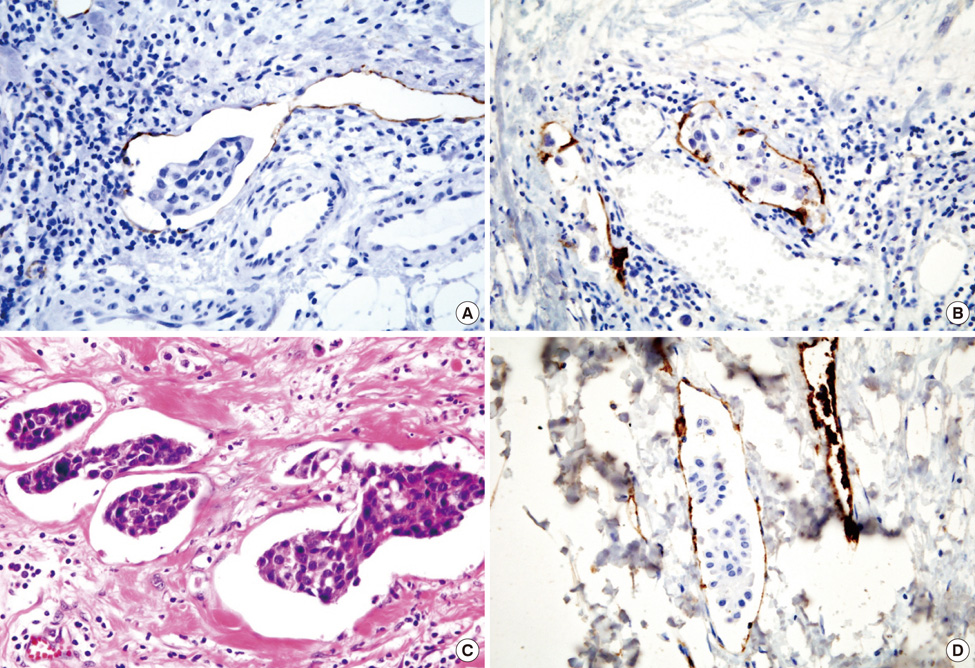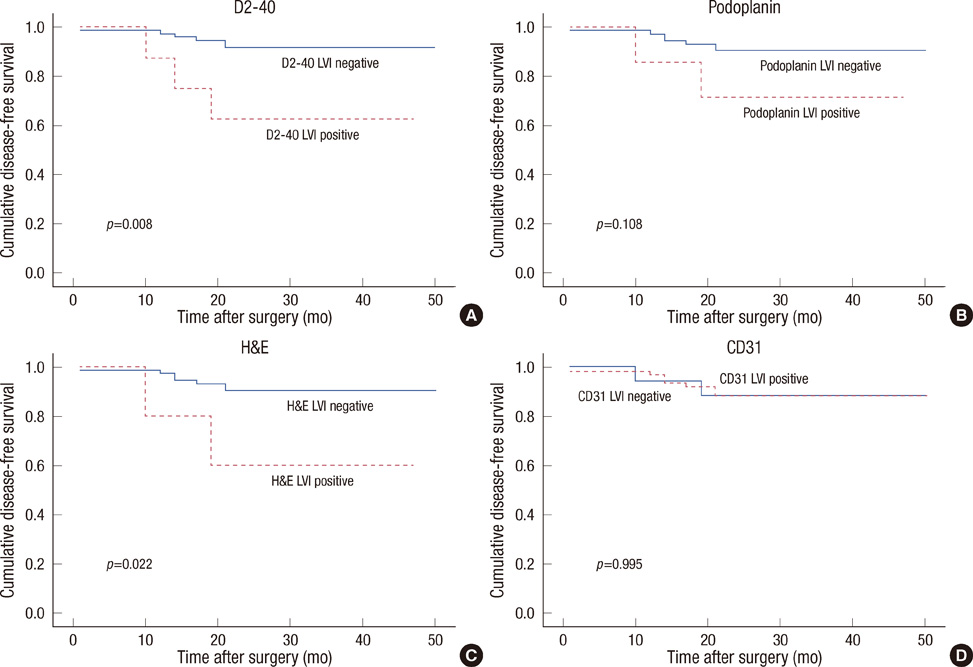J Breast Cancer.
2011 Jun;14(2):104-111. 10.4048/jbc.2011.14.2.104.
D2-40, Podoplanin, and CD31 as a Prognostic Predictor in Invasive Ductal Carcinomas of the Breast
- Affiliations
-
- 1Department of Surgery, Korea University College of Medicine, Seoul, Korea. kujwbae@korea.ac.kr
- 2Department of Pathology, Korea University College of Medicine, Seoul, Korea.
- KMID: 2286508
- DOI: http://doi.org/10.4048/jbc.2011.14.2.104
Abstract
- PURPOSE
Distant metastasis and recurrence are major prognostic factors associated with breast cancer. Both lymphovascular invasion (LVI) and blood vessel invasion (BVI) are important routes for metastasis to regional lymph nodes and for systemic metastasis. Despite the importance of vascular invasion as a prognostic factor, application of vascular invasion as a histopathological criterion is controversial. The aim of this study was to distinguish LVI from BVI in prognosis and recurrence of breast cancer using an endothelial subtype specific immunohistochemical stain (podoplanin, D2-40, and CD31).
METHODS
Sections from 80 paraffin-embedded archival specimens of invasive breast cancer were stained for podoplanin, D2-40, or CD31 expression. Immunohistochemical staining results were correlated with clinicopathological features, such as tumor size, status of lymph node metastases, estrogen receptor status, progesterone receptor status, human epidermal growth factor receptor-2 expression, and recurrence. Patients with ductal carcinoma in situ and stage IV breast cancer were excluded.
RESULTS
A significant correlation was found between D2-40 LVI positivity and lymph node metastasis (p=0.022). We found a significant correlation between D2-40 LVI positivity and recurrence of breast cancer (p=0.014). However, no significant correlation was found between BVI and recurrence. A poorer disease free survival was shown for D2-40 positive LVI (p=0.003). In a multivariate analysis, the presence of D2-40 LVI positivity revealed a significant association with decreased disease-free survival.
CONCLUSION
D2-40 LVI positivity was a more prognostic predictor of breast cancer than BVI.
MeSH Terms
-
Antibodies, Monoclonal, Murine-Derived
Antigens, CD31
Blood Vessels
Breast
Breast Neoplasms
Carcinoma, Ductal
Carcinoma, Intraductal, Noninfiltrating
Disease-Free Survival
Epidermal Growth Factor
Estrogens
Glycosaminoglycans
Humans
Lymph Nodes
Multivariate Analysis
Neoplasm Metastasis
Prognosis
Receptors, Progesterone
Recurrence
Antibodies, Monoclonal, Murine-Derived
Antigens, CD31
Epidermal Growth Factor
Estrogens
Glycosaminoglycans
Receptors, Progesterone
Figure
Cited by 1 articles
-
Neutrophil to Lymphocyte Ratio May Predict Mortality in Breast Cancer Patients
Sevket Balta, Sait Demirkol, Ugur Kucuk, Hakan Sarlak, Omer Kurt, Zekeriya Arslan
J Breast Cancer. 2013;16(3):354-355. doi: 10.4048/jbc.2013.16.3.354.
Reference
-
1. Weigelt B, Peterse JL, van't Veer LJ. Breast cancer metastasis: markers and models. Nat Rev Cancer. 2005. 5:591–602.
Article2. Donegan WL. Tumor-related prognostic factors for breast cancer. CA Cancer J Clin. 1997. 47:28–51.
Article3. Goldhirsch A, Glick JH, Gelber RD, Coates AS, Thürlimann B, Senn HJ, et al. Meeting highlights: international expert consensus on the primary therapy of early breast cancer 2005. Ann Oncol. 2005. 16:1569–1583.
Article4. Goldhirsch A, Wood WC, Gelber RD, Coates AS, Thürlimann B, Senn HJ, et al. Progress and promise: highlights of the international expert consensus on the primary therapy of early breast cancer 2007. Ann Oncol. 2007. 18:1133–1144.
Article5. van den Eynden GG, van der Auwera I, van Laere SJ, Colpaert CG, van Dam P, Dirix LY, et al. Distinguishing blood and lymph vessel invasion in breast cancer: a prospective immunohistochemical study. Br J Cancer. 2006. 94:1643–1649.
Article6. Mohammed RA, Ellis IO, Lee AH, Martin SG. Vascular invasion in breast cancer: an overview of recent prognostic developments and molecular pathophysiological mechanisms. Histopathology. 2009. 55:1–9.
Article7. Podgrabinska S, Braun P, Velasco P, Kloos B, Pepper MS, Skobe M. Molecular characterization of lymphatic endothelial cells. Proc Natl Acad Sci U S A. 2002. 99:16069–16074.
Article8. Breiteneder-Geleff S, Soleiman A, Kowalski H, Horvat R, Amann G, Kriehuber E, et al. Angiosarcomas express mixed endothelial phenotypes of blood and lymphatic capillaries: podoplanin as a specific marker for lymphatic endothelium. Am J Pathol. 1999. 154:385–394.
Article9. Marks A, Sutherland DR, Bailey D, Iglesias J, Law J, Lei M, et al. Characterization and distribution of an oncofetal antigen (M2A antigen) expressed on testicular germ cell tumours. Br J Cancer. 1999. 80:569–578.
Article10. Fukunaga M. Expression of D2-40 in lymphatic endothelium of normal tissues and in vascular tumours. Histopathology. 2005. 46:396–402.
Article11. Kahn HJ, Marks A. A new monoclonal antibody, D2-40, for detection of lymphatic invasion in primary tumors. Lab Invest. 2002. 82:1255–1257.
Article12. Robbins P, Pinder S, de Klerk N, Dawkins H, Harvey J, Sterrett G, et al. Histological grading of breast carcinomas: a study of interobserver agreement. Hum Pathol. 1995. 26:873–879.
Article13. Engers R, Gabbert HE. Mechanisms of tumor metastasis: cell biological aspects and clinical implications. J Cancer Res Clin Oncol. 2000. 126:682–692.
Article14. Böhle AS, Kalthoff H. Molecular mechanisms of tumor metastasis and angiogenesis. Langenbecks Arch Surg. 1999. 384:133–140.
Article15. Ito M, Moriya T, Ishida T, Usami S, Kasajima A, Sasano H, et al. Significance of pathological evaluation for lymphatic vessel invasion in invasive breast cancer. Breast Cancer. 2007. 14:381–387.
Article16. Cunnick GH, Jiang WG, Douglas-Jones T, Watkins G, Gomez KF, Morgan MJ, et al. Lymphangiogenesis and lymph node metastasis in breast cancer. Mol Cancer. 2008. 7:23.
Article17. Valencak J, Heere-Ress E, Kopp T, Schoppmann SF, Kittler H, Pehamberger H. Selective immunohistochemical staining shows significant prognostic influence of lymphatic and blood vessels in patients with malignant melanoma. Eur J Cancer. 2004. 40:358–364.
Article18. Adachi Y, Nakamura H, Kitamura Y, Taniguchi Y, Araki K, Shomori K, et al. Lymphatic vessel density in pulmonary adenocarcinoma immunohistochemically evaluated with anti-podoplanin or anti-D2-40 antibody is correlated with lymphatic invasion or lymph node metastases. Pathol Int. 2007. 57:171–177.
Article19. Saad RS, Kordunsky L, Liu YL, Denning KL, Kandil HA, Silverman JF. Lymphatic microvessel density as prognostic marker in colorectal cancer. Mod Pathol. 2006. 19:1317–1323.
Article20. Youn SI, Kim BG, Cha SJ, Park SJ, Chang IT, Park SI, et al. Angiogenic and lymphangiogenic microvessel density in terms of the expression of CD31 and D2-40 in colon cancer. J Korean Surg Soc. 2007. 73:315–320.21. Kim TH, Kim YS, Choi YC, Kim BK, Lee TJ, Park YG. The significance of the lymphatic micro vessel density and vascular endothelial growth factor- C expression for colorectal cancer. J Korean Surg Soc. 2007. 73:406–411.22. Rabban JT, Chen YY. D2-40 expression by breast myoepithelium: potential pitfalls in distinguishing intralymphatic carcinoma from in situ carcinoma. Hum Pathol. 2008. 39:175–183.
Article23. Arnaout-Alkarain A, Kahn HJ, Narod SA, Sun PA, Marks AN. Significance of lymph vessel invasion identified by the endothelial lymphatic marker D2-40 in node negative breast cancer. Mod Pathol. 2007. 20:183–191.
Article24. Nime FA, Rosen PP, Thaler HT, Ashikari R, Urban JA. Prognostic significance of tumor emboli in intramammary lymphatics in patients with mammary carcinoma. Am J Surg Pathol. 1977. 1:25–30.
Article25. Kuru B, Camlibel M, Gulcelik MA, Alagol H. Prognostic factors affecting survival and disease-free survival in lymph node-negative breast carcinomas. J Surg Oncol. 2003. 83:167–172.
Article26. Braun M, Flucke U, Debald M, Walgenbach-Bruenagel G, Walgenbach KJ, Höller T, et al. Detection of lymphovascular invasion in early breast cancer by D2-40 (podoplanin): a clinically useful predictor for axillary lymph node metastases. Breast Cancer Res Treat. 2008. 112:503–511.
Article27. Wong JS, O'Neill A, Recht A, Schnitt SJ, Connolly JL, Silver B, et al. The relationship between lymphatic vessell invasion, tumor size, and pathologic nodal status: can we predict who can avoid a third field in the absence of axillary dissection? Int J Radiat Oncol Biol Phys. 2000. 48:133–137.
Article28. Kato T, Kameoka S, Kimura T, Nishikawa T, Kobayashi M. The combination of angiogenesis and blood vessel invasion as a prognostic indicator in primary breast cancer. Br J Cancer. 2003. 88:1900–1908.
Article29. Lauria R, Perrone F, Carlomagno C, De Laurentiis M, Morabito A, Gallo C, et al. The prognostic value of lymphatic and blood vessel invasion in operable breast cancer. Cancer. 1995. 76:1772–1778.
Article30. Kato T, Kameoka S, Kimura T, Nishikawa T, Kobayashi M. Blood vessel invasion as a predictor of long-term survival for Japanese patients with breast cancer. Breast Cancer Res Treat. 2002. 73:1–12.
Article
- Full Text Links
- Actions
-
Cited
- CITED
-
- Close
- Share
- Similar articles
-
- Angiogenic and Lymphangiogenic Microvessel Density in Terms of the Expression of CD31 and D2-40 in Colon Cancer
- CD31 and D2-40 Contribute to Peritoneal Metastasis of Colorectal Cancer by Promoting Epithelial-Mesenchymal Transition
- Expression of Survivin According to Malignant Progression of Breast Lesions
- Invasive Ductal Carcinoma of the Male Breast: A Case Report and Review of the Literature
- Factors related with Axillary Lymph Nodes Metastases in T1 invasive ductal carcinomas of the Breast



